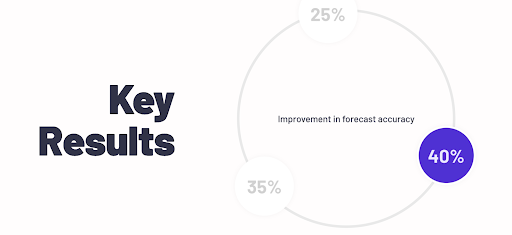Real estate professionals face a series of complex challenges, including rising interest rates, escalating construction costs, regulatory pressures, and the growing demand for ESG compliance. As financing costs climb, many are questioning how to adapt without compromising profitability, and how to anticipate market shifts before they impact their portfolios.
Traditional decision-making methods often fall short in addressing these dynamic factors. Predictive analytics, powered by AI, offers a solution, enabling firms to forecast market trends, optimize construction budgets, and identify profitable investment opportunities. By using these advanced tools, real estate professionals can make informed, data-driven decisions quickly, minimizing the risk of market volatility.
In this blog, we’ll talk about why you need predictive analytics in your real estate business and how RTS Labs’ tailored AI solutions help you with it.
What is Predictive Analytics in Real Estate?
Predictive analytics in real estate uses historical data, algorithms, and machine learning to forecast trends like property prices, rental yields, and buyer behavior. These insights help teams anticipate market changes and make more informed decisions on investments, risks, and resource allocation. AI models analyze data from sales history, economic factors, and demographics to predict demand or market shifts, allowing firms to act proactively.
Take Zillow’s Zestimate algorithm. It uses predictive analytics to estimate home values with a median error of just 5.9%. With this degree of accuracy, buyers and sellers feel more confident, and professionals are better positioned to set realistic pricing and investment expectations.
Why Predictive Analytics Matters in Real Estate
Predictive analytics can only deliver measurable outcomes like faster time-to-insight, higher forecasting accuracy, and improved lead conversion rates when the underlying infrastructure supports speed, scalability, and reliability.
One real estate firm worked with RTS Labs to address limitations in their legacy DevOps setup, which had created deployment bottlenecks for critical forecasting tools.
To solve this, RTS Labs re-engineered the firm’s DevOps pipeline using Kubernetes, Google Cloud Platform (GCP), and infrastructure-as-code. These upgrades enabled predictive models to be deployed more quickly, retrained more frequently, and integrated directly into core systems, such as CRMs and asset management tools.
As a result, the firm gained the ability to operationalize market predictions in real-time, improving decision-making, reducing downtime, and accelerating responses to tenant risks, pricing shifts, and maintenance needs.
The success of this transformation illustrates why more firms are prioritizing predictive capabilities. Below are core areas where predictive analytics delivers strategic value.
-
Expanding Data and Economic Volatility:
Real estate data now includes sales records, property characteristics, neighborhood demographics, environmental risks, and market trends such as average days on market, mortgage rates, and interest rates. It also considers consumer behavior, such as online search patterns, property viewings, saved listings, and engagement with marketing materials.
Predictive analytics processes this data to forecast demand shifts, price changes, and regional market fluctuations, enabling firms to adjust their sales strategies, property listings, and manage financial exposure more effectively in volatile economic environments. -
Fluctuating Interest Rates and Buyer Behavior:
Changes in mortgage and interest rates significantly impact home affordability, monthly payment thresholds, and buyer intent. Predictive models track these fluctuations in real-time and correlate them with buyer actions such as frequency of mortgage pre-approvals, drop-offs after loan eligibility checks, and shifts in budget preferences.
Based on these insights, firms can adjust property pricing, promote tailored financing options, and adjust listing timelines or promotional campaigns to align with current affordability levels and investor sentiment. -
Investor Expectations and Smart City Planning:
According to a Deloitte study, over 72% of real estate firms use predictive analytics to identify investment opportunities and manage risks. Predictive analytics plays an important role in smart city planning, where tools forecast urban growth, optimize zoning, and anticipate infrastructure needs.
Developers use these forecasts to select high-yield land parcels, time infrastructure investments, and plan sustainable urban expansion.
-
Managing Risk in Uncertain Markets:
Predictive analytics identifies early warning signs of asset underperformance, such as declining tenant credit scores or oversupply in specific segments. By modeling the projected impact of these trends, firms can take targeted actions. They might reallocate capital to higher-performing assets or tighten lease approvals based on a tenant’s credit score and payment history. They may also revise asset valuations to reflect updated income forecasts and local market saturation. These steps help limit downside risk and preserve overall portfolio value.
-
A Strategic Advantage in a Competitive Market:
Real estate firms that integrate predictive insights into strategic planning consistently outperform competitors in volatile markets. They can forecast demand shifts, analyze rental trends in emerging areas, and assess capital appreciation driven by new infrastructure projects. Additionally, they can project internal rates of return (IRR) across various asset classes. These insights help make faster, evidence-based decisions well before the broader market responds.
Benefits of Real Estate Predictive Analytics
According to MMR research, the use of AI in the real estate market, heavily driven by predictive analytics, is projected to reach $1335.89 billion by 2030, growing at a CAGR of 35%. But why are real estate firms investing heavily in predictive analytics?
Here are some of the most empowering benefits of predictive analytics that make it worth the investment:
1. Improved Property Valuation and Pricing
While traditional valuation models emphasize location and recent sales history, predictive analytics expands the scope to include local economic indicators, consumer behavior trends, infrastructure development, and demographic patterns. These data points enhance pricing accuracy, enabling firms to set competitive rates that are aligned with both short- and long-term market potential.
2. Accurate Market Predictions
Instead of relying on static historical data, predictive models analyze evolving inputs, such as shifts in interest rates, employment trends, buyer sentiment, and inventory cycles. These forecasts help real estate professionals to adapt their sales strategies proactively, anticipate rental fluctuations, and align product offerings with projected demand.
3. Enhanced Investment Decisions
Predictive analytics enables investors to screen and prioritize high-potential properties by evaluating variables like regional price appreciation, tenant churn rates, and comparable asset performance. These insights support faster due diligence, reduce reliance on assumptions, and allow for more agile portfolio allocation.
Suggested read: 5 Ways AI Demand Forecasting Can Enhance Your Business Success
4. Operational Efficiency and Task Automation
From tenant scoring to asset tracking, predictive systems streamline repetitive processes by automatically analyzing incoming data. Real estate firms use these tools to identify time-sensitive leads, escalate urgent maintenance issues, and refine customer engagement workflows, reducing operational bottlenecks and improving service delivery.
5. Dynamic Pricing Strategies
Instead of fixed-price listings, firms can deploy pricing algorithms that respond in real time to market saturation, buyer intent signals, and macro trends. These dynamic pricing models reduce vacancies, increase margins, and allow firms to fine-tune revenue generation across different asset classes and geographies.
6. Identifying Risks and Opportunities in Portfolio Management
With access to historical patterns and real-time analytics, portfolio managers can identify early indicators of underperformance, such as deteriorating neighborhood metrics, rising vacancy rates, or credit deterioration among tenants. At the same time, models surface growth markets, helping teams rebalance holdings, prioritize renovations, or explore strategic divestments based on projected ROI.
Use Cases of Predictive Analytics in Real Estate
Predictive analytics is transforming the way real estate professionals make decisions, optimize operations, and manage risk. Below are key use cases that demonstrate its value:
1. Market Trend Forecasting
Real estate professionals need more than historical comps to stay competitive. They require timely insights into future price shifts, rental demand, and supply dynamics. Predictive models analyze a mix of historical data, migration patterns, economic indicators, and consumer behavior signals to project short- and long-term market movements. It also analyzes live data like migration inflows, employment rates, mortgage interest rates, and Google search volume by zip code to forecast price appreciation or depreciation in specific neighborhoods.
These insights allow firms to recalibrate inventory, time listings effectively, and position assets for optimal return.
RTS Labs builds custom forecasting models and AI-powered dashboards tailored to your local market dynamics. Integrated directly into your existing workflows, these tools enable continuous monitoring of pricing fluctuations and emerging demand pockets, helping you stay ahead of change rather than react to it.
2. Lead Scoring and Buyer/Seller Identification
Precision matters more than volume when it comes to converting qualified leads in competitive real estate markets. Predictive analytics evaluates CRM data, engagement history, website behavior like property view patterns, email open rates, and social media engagement, and demographic variables to rank leads based on likelihood to convert. This prioritization helps sales teams focus outreach, personalize messaging, and shorten conversion cycles.
With RTS Labs, you get AI-based lead scoring tools embedded in your CRM, enabling automated lead qualification, priority-based targeting, and smarter allocation of sales resources for better conversion outcomes.
3. Property Valuation and Dynamic Pricing Optimization
Static pricing often lags behind market shifts. Instead of fixed pricing, ML models adjust property value forecasts daily by factoring in recent nearby sales, listing velocity, and foot traffic from virtual tours. It further improves accuracy by analyzing real-time sales data, local demand signals, and regional growth metrics.
These inputs allow sellers to respond quickly to changing conditions, price assets competitively, and protect margins.
Custom-built by RTS Labs, these pricing engines use real-time data and predictive analytics to generate precise, adaptive price points. The system delivers continuously updated valuations and pricing recommendations that adjust as new data comes in, reducing pricing delays and improving revenue performance.
4. Investment Analysis and Portfolio Optimization
Instinct alone cannot uncover high-return properties. Predictive models evaluate factors such as past property performance, local economic conditions, construction timelines, and historical rental income trends to rank investment opportunities. These models also flag properties that show signs of declining value or increasing vacancy rates, allowing firms to allocate capital more strategically and make informed decisions on portfolio adjustments.
RTS Labs develops portfolio optimization tools that apply predictive algorithms to structured investment data. The platform automates risk scoring, surfaces growth opportunities, and enables firms to manage larger portfolios with greater precision and speed.
5. Vacancy Prediction and Risk Mitigation
Understanding tenant behavior and market conditions is essential for maintaining high occupancy rates. Predictive models analyze factors such as lease renewal dates, payment histories, local market demand, and historical tenant turnover rates to predict vacancies. Property managers can use these predictions to proactively initiate lease renewals, offer targeted retention incentives, or adjust rental listings before vacancies occur.
RTS Labs integrates predictive vacancy models into your property management systems, enabling early detection of potential tenant turnover. These models also assess payment risk, giving teams the lead time needed to act on at-risk leases and stabilize rental income.
6. Fraud Detection and Compliance Risk Assessment
Unusual transaction behavior, such as mismatched identities, inflated valuations, overvalued properties, or multiple transactions by the same buyer, can indicate fraud. Predictive analytics detects these irregularities in real time by analyzing buyer profiles, transaction history, and market norms. Early alerts help firms investigate issues before they result in legal exposure or financial loss.
Fraud detection models from RTS Labs are tailored to your risk profile and integrated directly into your transaction systems to flag anomalies in real time and support compliance enforcement.
Also read: How Machine Learning Is Boosting Fraud Detection Across Industries
7. Customer Segmentation and Relationship Personalization
Using generic messaging for all buyers weakens engagement and slows down deal progression. Predictive models segment prospects based on factors such as purchase history, browsing behavior, lifestyle preferences, and frequency of interaction. These insights enable tailored property recommendations, personalized communication, and targeted campaigns aligned with each customer’s intent.
Integrated into your CRM and marketing tools, RTS Labs’ AI segmentation models automate how you group and engage prospects, resulting in more relevant messaging and faster deal movement.
8. Inventory and Asset Lifecycle Management
Managing hundreds of assets across listing, sale, and maintenance stages requires foresight and careful planning. Predictive analytics tracks asset conditions, historical upkeep cycles, and market activity to forecast when properties are likely to need maintenance, renovation, or repositioning. These insights improve planning for capital expenditures and workforce scheduling.
RTS Labs delivers asset lifecycle solutions that combine predictive analytics with real-time inventory tracking. Teams gain visibility into each property’s condition and timeline, reducing maintenance gaps and ensuring efficient resource deployment.
How to Implement Predictive Analytics in Real Estate
A successful predictive analytics implementation demands a structured, objective-driven process that aligns technical capability with business need. Below are six essential steps to ensure your analytics investment delivers measurable value:
1. Define the Business Objective
Start by identifying the specific outcome you want to improve—whether it’s forecasting high-demand locations, reducing tenant turnover, or improving pricing accuracy. The business goal will shape what data you collect and how the model is built.
To support this, RTS Labs works closely with your team to define measurable objectives and deliver models tailored to your use case, from pricing optimization to market entry analysis.
Here’s a guide on how to align AI initiatives with business objectives
2. Identify and Gather Relevant Datasets
Accurate predictions depend on the right mix of datasets. These may include internal records (leases, sales history), external inputs (demographics, interest rates), and behavioral data (lead activity, web searches). Data hygiene and integration are critical at this stage.
Using scalable data pipelines and modern architecture, RTS Labs ensures your systems are equipped to capture, clean, and unify relevant data, laying the groundwork for reliable analytics.
Read how domain-specific data enhances the Value of GenAI
How RTS Labs makes a difference?
OCN.ai, founded by Jeremy McKane, set out to monitor ocean health in real time, comparing their vision to a “Fitbit for the ocean.” However, collecting and interpreting vast, fragmented oceanic data from multiple sources proved to be a major challenge, limiting their ability to detect anomalies and provide actionable insights.
RTS Labs partnered with OCN.ai to integrate high-resolution NASA satellite data and IoT buoy sensors into a unified platform. Together, they developed tools like the Ocean Risk Score, which distills complex data into a single, easy-to-interpret metric. This enhanced OCN.ai’s ability to track ocean health at scale and deliver real-time, science-based recommendations to protect marine ecosystems.
3. Choose the Right Model Architecture (ML/AI Tools)
Different goals require different model types. For example, forecasting vacancy rates may require time-series models, while investment scoring could call for classification or ensemble methods. Model architecture should align with both the business context and data volume.
Using its deep AI expertise, RTS Labs selects and customizes the right machine learning approach, optimizing for accuracy, scalability, and compatibility with your workflows.
4. Train and Validate Models
Training a model is not just about fitting data; it involves rigorous testing to ensure generalizability. Techniques such as cross-validation and out-of-sample testing help uncover performance issues before deployment.
To ensure robustness, RTS Labs applies advanced evaluation techniques and refines models through iterative tuning, minimizing false signals and maximizing predictive reliability.
5. Integrate Predictions into Business Workflow
Predictions should drive action. Whether it’s surfacing tenant risk scores inside a CRM or updating pricing guidance in a listing dashboard, insights must be accessible to the right teams at the right moment.
Through seamless integration, RTS Labs embeds these predictive capabilities into your existing platforms, delivering real-time recommendations without disrupting daily operations.
6. Monitor, Retrain, and Improve Continuously
As new data becomes available and markets shift, models must evolve to stay relevant. Regular retraining and performance tracking help prevent model drift and ensure long-term effectiveness.
RTS Labs provides automated monitoring and ongoing support, helping you adapt quickly to market changes while maintaining high model performance and ROI.
Best Practices for Implementing Predictive Analytics in Real Estate
Successful implementation of predictive analytics in real estate goes beyond tools and data. To achieve long-term success, follow these best practices:
- Prioritize one use case with immediate business impact, such as dynamic pricing for high-turnover listings or risk scoring for tenant retention, before expanding to broader applications.
- Clean, current, and well-structured data is non-negotiable. Set up validation checkpoints, automate cleansing tasks, and unify data sources before feeding them into models.
- Use interpretable models or include post-hoc explanations to show which variables influenced predictions, especially when presenting to stakeholders who need to justify decisions. You can apply post-hoc methods, such as LIME or SHAP, to explain predictions.
- Connect predictive outputs directly to CRM, asset management, or property maintenance platforms, so insights influence daily actions rather than living in isolation. For example, use APIs to connect predictive models to Salesforce to automatically incorporate insights into daily operations and decision-making, such as optimized pricing or maintenance forecasts.
Dysport, a Richmond-based printing and marketing company, struggled to leverage Salesforce and Pardot within its existing systems fully. Off-the-shelf CRM setups weren’t addressing the unique needs of their sales and marketing processes.
RTS Labs worked closely with Dysport’s leadership to assess their current ecosystem and developed a custom Salesforce CRM solution tailored to their workflows. Instead of taking a generic implementation approach, RTS Labs focused on educating the entire sales team, empowering them to use Salesforce beyond its standard features.
- For high-value or high-risk decisions, such as large property acquisitions or lease negotiations, establish escalation paths that allow human experts to review and validate predictive recommendations.
- Schedule periodic retraining cycles based on model performance metrics, new data availability, or shifts in market dynamics to prevent model drift.
- Align KPIs for model success with specific business metrics, such as reduced vacancy rates, increased lead conversion rates, or improved rental yield to ensure adoption is tied to measurable outcomes.
- Standardize governance for model inputs, training data, and decision thresholds to reduce compliance risks and ensure consistency across teams.
To support this approach, RTS Labs works with real estate firms to operationalize best practices across every stage of analytics maturity. From building robust data pipelines to integrating custom models into transaction workflows, we ensure predictive systems are explainable, actionable, and continuously optimized for changing market conditions.
“Our billing module needed to be rewritten and that is a key and pivotal project for any organization but in particular for a private equity group who is actually looking to make certain that we had the stability and structure that we needed and the infrastructure from an IT standpoint to handle our operations on a day-to-day basis as well as position ourselves to go back to market at the appropriate time. It was key and critical that you find someone who is a trusted partner who you can tell will act with integrity above all else and I really found that in RTS.”
– Amy Daniels
World Wide Express
Prebuilt Tools vs Custom Predictive Analytics Solutions Developed by RTS Labs
When implementing predictive analytics for real estate, companies have two options: prebuilt tools or custom solutions. Understanding their key differences will help determine the right fit for your business.
| Criteria | Prebuilt Tools | Custom Predictive Analytics by RTS Labs |
|---|---|---|
| Flexibility | Limited | Highly flexible; tailored to specific business needs |
| Requirement | Requires minimal setup and customization | Requires initial analysis and ongoing refinement |
| Cost Over Time | Lower initial cost, but higher long-term costs; due to frequent updates or upgrades requirements, licensing and scaling fees | Higher upfront cost, but better long-term ROI |
| Integration Capability | Limited integration with existing systems and workflows | Seamless integration with existing platforms, CRMs, and other business systems |
| Accuracy & Adaptability | May not be as accurate for specific real estate markets or changing conditions | Highly accurate, with models designed to adapt to changing market conditions and business requirements |
| Support & Scalability | Limited support for customization or scaling beyond basic needs | Ongoing support and scalable solutions as business grows, with continuous optimization |
Predictive Analytics Is the Future of Real Estate — Build It with RTS Labs
While prebuilt tools offer an off-the-shelf solution, custom predictive analytics solutions, developed by RTS Labs, are tailored to your unique needs. They offer greater flexibility, more accurate predictions, and long-term scalability.
With AI and predictive analytics in real estate, new and exciting trends are also emerging that can reshape this industry further, like:
- AI-powered ESG forecasting predicts the environmental and social impacts of investments, driving sustainable development.
- 3D mapping and predictive zoning enhance urban planning by forecasting future land use and infrastructure needs.
- Hyperlocal demand models provide precise insights into property values and market trends at the neighborhood level.
As the real estate industry continues to evolve, staying ahead of these trends presents an opportunity to become a market leader, and RTS Labs makes that possible for you.
As AI specialists in real estate and construction, RTS Labs provides you:
- End-to-end AI consulting for construction and real estate workflows
- Predictive maintenance to reduce equipment downtime
- Automated cost estimation to improve budget accuracy
- Schedule optimization to minimize delays and improve project timelines
- Safety monitoring using AI to identify and mitigate on-site risks
- Machine learning integration for:
- Project scheduling
- Equipment upkeep
- Material forecasting
These solutions help reduce delays, lower costs, and improve operational efficiency, translating data insights into measurable field results.
Contact RTS Labs today to get started with tailored AI solutions that drive measurable results and future-proof your operations.
FAQ
How long does it typically take to implement a predictive analytics solution in real estate?
A basic model may take a few weeks, while a fully customized, end-to-end solution with system integration may take longer. RTS Labs works closely with you to define milestones and accelerate time to deliver the system in 60-90 days.
Can predictive analytics be used for ESG compliance or sustainability initiatives?
Yes. Predictive models can assess energy usage, carbon footprint, and long-term sustainability risks in properties. They help identify areas for green retrofitting and forecast the impacts of ESG-related investments.
Is predictive analytics suitable for small and mid-sized real estate firms, or only enterprise-level companies?
Predictive analytics is scalable and can benefit firms of all sizes. Small and mid-sized firms can begin with focused use cases, such as pricing optimization or lead scoring. RTS Labs offers modular, customizable solutions to ensure smaller teams get ROI without overinvesting in unused features.











